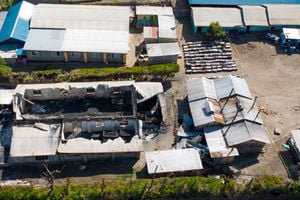Gigantic breasts ‘don’t have to bring you down’

Gigantomastia is a rare condition that is caused by the excessive growth of breast tissue in one or both breasts.
In her teenage years, Ruth Makena was restricted from participating in sports or social activities due to the size of her breasts. She noticed that her bust was three times bigger than her peers and her cup size had already grown to 38C.
As she grew older, they grew bigger and began making her life complicated. On some days, she would wake up in the morning to find that her shoulder was dislocated.
“I often stayed in my room and only left the house when necessary in fear of the stares, sneers and unsolicited advice I received from strangers on the streets,” Ruth recalled.
After several visits to the orthopaedic’s clinic, her doctor discovered that the excessive weight in her breast was pulling down her shoulders, which caused recurrent dislocation. She was then diagnosed with gigantomastia in 2011 while she was studying law at the Catholic University of East Africa. Ruth’s cup size had grown to 42GG by that time.
There are two types of measurements that make up a bra size: The chest size and the cup size. The chest size is represented by a number and is the part of the bra that runs across a woman’s chest. The cups are the parts that hold the breasts and letters symbolise different sizes. The average cup size ranges between cup size AA to DD.
Gigantomastia, also known as breast hypertrophy, is a rare condition that is caused by the excessive growth of breast tissue in one or both breasts.
Non-cancerous condition
The exact cause is unknown but it is known to occur during puberty, pregnancy and after using certain medications such as D-penicillamine used to treat heavy metal poisoning. Breast growth can happen unexpectedly in a few years but there have been some cases where a woman’s breast grew three or more cup sizes in a few days. It is confirmed to be a non-cancerous condition, but it can make normal life difficult for women suffering from it.
Prof Josephat Mulimba, Ruth’s orthopaedic surgeon, recommended plastic surgery to have the excessive breast tissue removed. Some 7.3 kilos of breast tissue was extracted from Ruth’s chest in a four-hour long surgery. That is the standard weight of a five-month old-baby and she had been carrying the pressure on her shoulders and chest for several years.
“My recovery process after breast reduction was tough and scary. I did not have anyone to talk to about what I was going through. Everything was new to me. The only person I heard of going through with the surgery was an American celebrity named Queen Latifah,” she said.
Ruth turned to the internet for guidance since there was not much provided locally.
Despite this, she fully recovered without any complications and she was back to her normal life with her cup size at 40C six weeks after the surgery.
“I founded the Gigantomastia Foundation because I saw a need to reach out to many women suffering silently who did not know that whatever they were going through was a defined condition with a solution. I made it my business to demystify the beliefs around the condition by educating people and spreading awareness,” she said.
The foundation has teamed up with medical practitioners and volunteers to help make the surgery and recovery a smooth process for beneficiaries.
Most insurance firms decline to cover costs for breast reduction surgery and regard it as a cosmetic procedure.
Yet some of the symptoms of the condition such as loss of nipple sensation caused by nerve damage, can greatly affect breastfeeding mothers, according to a study by Dr Mangla Mishu, an obstetrician and gynaecologist.
The foundation offers their services at a subsidised rate as well as some pro bono for special cases. Over 200 patients have benefited from the organisation’s efforts.
Emotional support is also a vital role that the foundation plays as they continue to create a safe space for patients before and after surgery.
“We are looking into unearthing the underlying issues that may have affected the patients’ self esteem. Our core purpose is to have them live a holistic life,” said Ruth.




